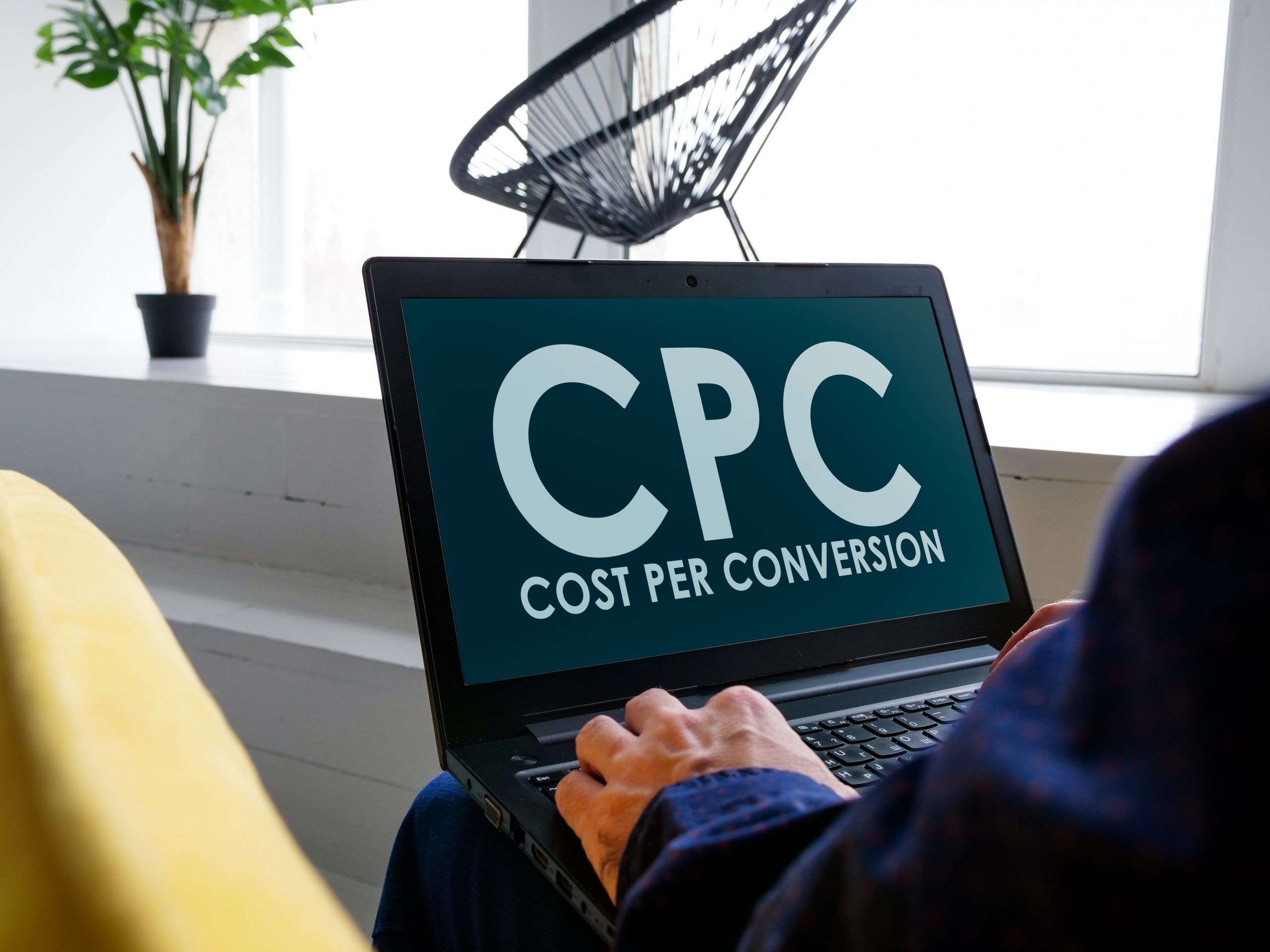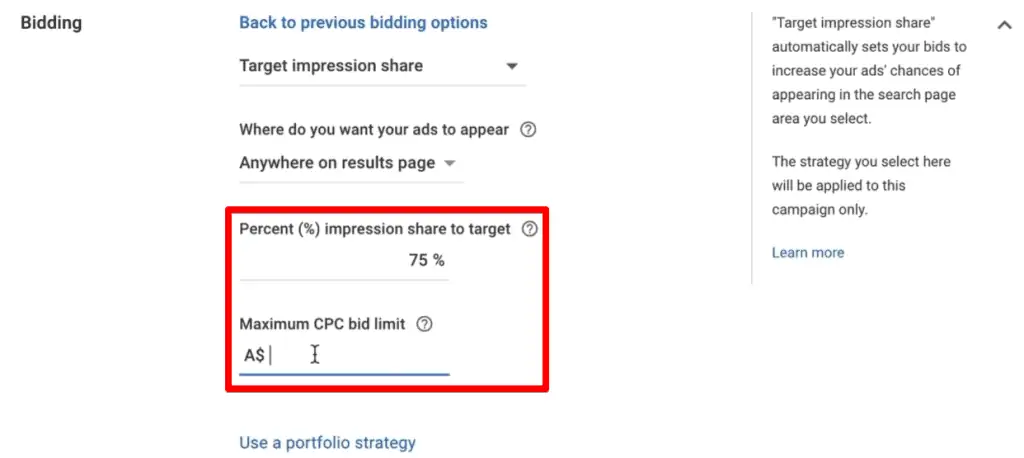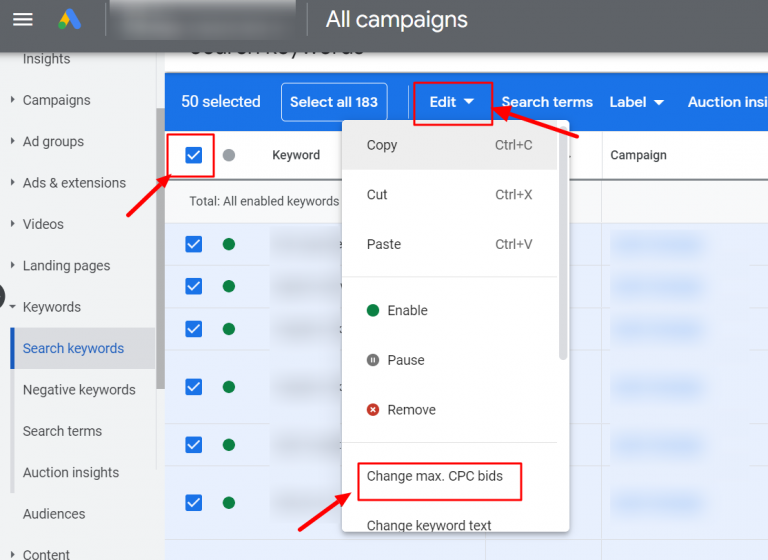How to Set Max CPC in Google Ads: A Step-by-Step Guide

Determining the maximum cost-per-click (CPC) for your Google Ads campaign can be a critical step in managing your ad spend. It involves assigning the greatest amount you are willing to pay for each click your ad receives. This amount significantly impacts both the frequency your ads are shown and your return on investment (ROI).
However, the process of setting up the max CPC is not always straightforward for beginners or even for those who are moderately experienced with Google Ads. This can lead to ad campaigns that operate at less than their full potential, draining your budget quickly without yielding the desired results. But don’t be daunted. In this article we will navigate you through the necessary steps describing how to effectively specify a max CPC in Google Ads.
Understanding how to adjust your max CPC is a crucial part of mastering Google Ads. There isn’t a one-size-fits-all solution, and the appropriate CPC depends on several factors, such as the competitiveness of your industry and the profitability of your products or services. This article will provide guidance on optimizing your bidding strategy accordingly.
Understanding CPC: Methods to Establish Maximum CPC in Google Advertising Services
Google advertising services provide the luxury of enhancing your business outreach, attracting potential customers by effectively setting up quality campaigns. However, to make the most out of these campaigns, understanding and setting up the maximum Cost per Click (CPC) is imperative. Maximum CPC, known as Max CPC, is the utmost amount Google advertising services charge for a click on your advertisement in a specific campaign. It directly influences the advertisement’s performance and directly impacts your ad ranking.
Adopting an efficient Max CPC strategy is not only beneficial for visibility on search pages but also crucial for profitable pay-per-click (PPC) advertising. Intuitively setting this crucial part of your advertisement strategy can affect how often your ads are shown, your position among other ads, and the cost-effectiveness of your campaigns.
Denoting Maximum CPC in Google’s Advertising Platform
To control the amount you spend on clicks in Google advertising services, follow these steps:
- First, log into your Google Ads account.
- Navigate to the Campaigns or Ad groups page.
- Select the campaign or ad group you want to edit.
- Click the pencil icon in the “Max. CPC” bid column next to the campaign or ad group you want to change.
- Enter the new bid amount and save the changes.
Strategically defining Max CPC can be based on determining a target return on ad spend (ROAS) or making data-driven decisions based on the performance results of your ads. Analyze both historic and real-time data to set a Max CPC that balances visibility and return on investment.
Remember: Strategic allocation to Max CPC not only determines visibility of your ads but also the monetary success of your campaigns. Consequently, understanding and mastering the process of setting Max CPC in Google advertising services goes a long way in making your digital advertising strides rewarding.
Setting Max CPC in Google Ads
| Aspect | Description | Steps to Set Max CPC | Benefits | Considerations |
|---|---|---|---|---|
| Manual CPC Bidding | Manually set the maximum CPC for keywords, ad groups, or campaigns to control your ad spend. | 1. Log in to Google Ads. 2. Go to the campaign, ad group, or keyword settings. 3. Set the Max CPC. | – Full control over bid amounts. – Adjust bids based on specific goals and performance. | – Requires continuous monitoring and adjustment. – Time-consuming for large campaigns. |
| Automated Bidding | Use automated bidding strategies like Target CPA or Target ROAS to let Google set CPC bids dynamically. | 1. Select the desired automated bidding strategy. 2. Set a target or budget. 3. Let Google optimize bids. | – Time-saving. – Enhanced precision. – Adaptation to changing market conditions. | – Requires sufficient historical data for accurate optimization. – Less manual control over bid amounts. |
| Enhanced CPC (eCPC) | Enable eCPC to let Google adjust your manual CPC bids in real-time to improve ad performance. | 1. Enable eCPC in your campaign settings. 2. Set your manual CPC bids. | – Manual control with automated optimization. – Potential for improved conversions. | – May increase bid amounts for clicks with higher conversion likelihood. – Limited budget control. |
Grasping the Concepts of Google’s Promotional Platform and Maximum Cost-Per-Click
The advertising service offered by Google, popularly known as Google Ads, empowers businesses of all sizes to display ads on Google’s search engine results pages (SERPs) and its vast network of partner sites. This platform uses an auction-based system where advertisers bid on keywords relatable to their product or service. Google Ads are shaped around the concept of pay-per-click, in which advertisers are only charged when their ads are clicked, leading us to the importance of understanding Maximum Cost-Per-Click (Max CPC).
Max CPC can be viewed as the highest amount an advertiser is willing to pay for a single click on their ad. It’s an integral part of Google’s auction process, significantly influencing the ad’s placement in SERPs and the cost of every click-through. Knowing how to manage this aspect of your Google Ads efficiently can make a massive difference to your campaign’s overall success and your return on investment.
How to Effectively Manage Your Max CPC
To set the highest cost you’re prepared to pay for an ad click effectively, you must first identify the value each site visitor brings to your business. Analyze your website’s conversion rate, your profit margins for each product or service, and the portion of your profits you’re willing to allocate to Google Ads.
Reducing your Max CPC won’t always lead to cost savings. You might end up paying less per click, but a lower ad placement might reduce the total number of clicks and conversions. Thus, increasing the Max CPC doesn’t necessarily mean you’ll exceed your budget. Google’s algorithms only raise your bid when necessary, and often you’ll be paying less than your Max CPC for clicks.
- An understanding of your audience can optimize your Max CPC efficiently. Consider demographics, platforms used (mobile or desktop), and geographical location while configuring your Max CPC.
- Another critical factor is the quality score which is Google’s assessment of the quality and relevance of your keywords, landing pages, and PPC ads. Achieving a high-quality score can decrease your Max CPC.
- You can also opt for automated bids where Google automatically adjusts your bid based on your campaign’s goals. This can be a great strategy for beginners.
In conclusion, a clear understanding of Google Ads and Max CPC is essential for running successful campaigns and achieving wider visibility in Google’s SERPs, at an affordable cost.
The Importance of Proper Cost-Per-Click Setting for Your Promotions
Ensuring that the per-click cost limit for your promotional campaigns is accurately set is an integral part of managing paid online advertising, especially in the world of Google promotions. This setting can directly influence the reach and efficiency of your campaigns, playing a pivotal role in achieving your advertising targets and ensuring appropriate spending.
The idea of optimizing the highest cost per click is not to cut back on your advertising budget, but rather to make sure every dollar you invest works in your favor. Precise financial control over what you are willing to pay for each click on your advert is paramount to flourishing promotion performance, as it facilitates judicious use of your marketing resources.
Major Impacts of Correctly Determining the Top Limit for Per Click Cost
- Improvement of Ad Ranks: Google takes into consideration the maximum bid you’re inclined to pay while determining your ad’s position compared to other advertisements. An efficient upper limit for your cost per click can assist in enhancing your ad’s visibility.
- Budget Management: A well-calculated per-click cost limit can prevent you from overspending on low conversion traffic, enabling more financial resources to be directed towards potential high-conversion audiences.
- ROI Optimization: By curiously monitoring and tweaking your top cost-per-click, you effectively monitor your return on investment. This ensures you aren’t overpaying for clicks and getting the most results out of your budget.
- Competitive Advantage: A shrewd max CPC setting can provide an edge over competitors by ensuring your ads reach the right audience at the right budget, making your campaigns more impactful.
In conclusion, setting the right maximum cost-per-click is not just a budgeting strategy, but a comprehensive approach towards enhancing advertisement performance, driving better conversion rates, improving the marketing return on investment, and gaining a competitive edge in the bustling landscape of Google promotions.
A Comprehensive Instruction on Setting Your Maximum Cost-per-click
The maximum cost-per-click (Max CPC) significantly impacts the performance of your Google advertising campaigns. It is the highest amount you’re willing to pay for a click on your ad. Therefore, setting the Max CPC requires careful consideration and strategic planning.
To help you navigate this crucial aspect of Google Ads, here’s a step-by-step guide on determining your maximum cost-per-click. Follow these stages to find a balance between affordable advertising and competitive visibility on the Google platform.
A Comprehensive Process to Find Your Maximum CPC
Step 1: Define Your Profit Margins
Before diving into Google ads, start by understanding your business operations. Establish what your average profit margin per customer is. This figure indicates how much you stand to earn from each new buyer conversion.
Step 2: Determine Your Conversion Rate
Next, find out the conversion rate from your past pay-per-click campaigns. If you’re new to this, consider using benchmarks from your industry. The conversion rate helps you predict the percentage of customers who will make a purchase after clicking on your ad.
Step 3: Calculate Your Maximum CPC
With your profit margins and the conversion rate at hand, you can now calculate your max CPC. To start, multiply the profit per customer by the conversion rate. The result will give you your maximum CPC. For example, if your profit per customer is $50, and your conversion rate is 2%, your max CPC is $1 ($50 * 0.02).
Note: Always fine-tune your max CPC. Adjusting your Max CPC regularly will help stay competitive and reflect any changes in your profit margins or conversion rate.
Max CPC: Balancing Affordability and Visibility
In conclusion, Max CPC is a balancing act. You need to determine a bid amount that allows you to compete effectively with other advertisers without compromising your advertising budget. This step-by-step guide will help you accomplish this task to ensure your Google advertisements achieve the desired results.
Configuring Your Highest Bid per Click in Google Ad Interface
Many advertisers find the need to customize their bid cap per click while using the Google Ad interface. The maximum cost-per-click (CPC) bid is a useful parameter that can be adjusted, allowing for precise control over an advertising budget. With it, you can set limits on the highest amount you’re willing to pay for a single click on your Google ad.
Essentially, higher bids can position your ads more favorably in Google’s search results, possibly driving more traffic to your website. However, realizing an optimal balance between ad expenditure and click volume is crucial, hence the need to set an appropriate upper limit for a CPC bid.
Steps to Customize Your Highest CPC in Google Ads

First, log into your Google Ads account. Navigate to the appropriate campaign or ad group where you’d like to set the max CPC. The max CPC can be set at either the ad group level or for individual keywords in a campaign.
- Click ‘Settings’ and select either ‘Ad group settings’ or ‘Keyword’ settings.
- Enter the preferred maximum bid in the Max CPC field.
- Click ‘Save’ to keep your changes.
Remember, if you’re setting the max CPC at the keyword level, this overrides any max CPC set at the ad group level.
All changes to the max CPC can be done without interrupting the ad’s operation. Should the need to adjust the max CPC arise, due to factors like competition or budget adjustments, you can do so at any time.
Enhancing Your Ad Promotion Using an Appropriate Maximum Cost-Per-Click
Launching an effective and efficient ad campaign is a strategic task that requires careful planning and execution. One of the important aspects in Google advertising you need to pay attention to is deciding on the right maximum cost-per-click (CPC). A well planned maximum CPC not only helps your budget but also promotes better ad performance.
The maximum CPC is the most you’re willing to pay when someone clicks your ad. Therefore, setting the accurate CPC plays a significant role in managing your campaign costs while aiming for the top ad positions. This is where optimization comes into play. By optimizing, you ensure that your campaign is producing the desired results without overspending on your advertising budget.
Steps to Optimize Your Ad Campaign with a Suitable Top CPC
- Understand your ad campaign goals:Before determining the highest CPC, it’s crucial to understand the main goals of your ad campaign. Are you targeting for higher ad ranking, increased clicks or maximum conversions? Your campaign’s objectives will greatly shape your budget allocation and thus, your maximum CPC.
- Estimate a starting CPC: Base this on the average of what advertisers pay for a click in your industry. This serves as a benchmark and helps you get a sense of prevailing market trends. Adjusting from this starting point, you can set your highest CPC that aligns with your ad campaign’s objectives and your budget.
- Monitor and adjust the CPC regularly: Keep a watchful eye on your ad campaign’s performance. Monitor metrics like Quality Score, click-through rate, conversion rate, and average ad position to see how they are affected by your current CPC. If significant improvement or decline is noted, you can adjust your maximum CPC accordingly.
- Experiment with automated bid strategies: Google Ads offers automatic bidding strategies like Maximize Clicks and Target CPA which can adjust your bid automatically to either get the most clicks or conversions possible within your budget.

By following these steps, you can optimize your ad campaign effectively ensuring you aren’t overstepping your ad budget while still obtaining your desired campaign performance.
Professional Advice for Effectively Managing Your CPC Limit Strategy

Mastering Google Ads requires thoughtful control over your Cost Per Click (CPC) limit strategy. A well-managed CPC strategy not only allows you to optimize your advertising budget but also drives targeted traffic to your website. However, doing this successfully requires a deep understanding of your campaign goals and the competitive search landscape.
You should remember that setting the highest limit on your CPC doesn’t necessarily yield the best results. Instead, it’s about finding a balance between what you’re willing to pay for clicks and keeping your adverts competitive to ensure they’re seen by the right audience. Here are some professional advice for managing your CPC strategy to get the most out of your Google Ads.
1. Understand Your Campaign Goals
Knowing your campaign goals helps you to allocate your budget efficiently and set a suitable limit on your CPC. If brand awareness is your primary goal, your focus should be on maximizing impressions. But, if you’re aiming for clicks or conversions, your CPC strategy should revolve around these objectives.
2. Use Bid Simulators
Bid simulators can help you see how different CPC limits could affect your ad performance. They provide an estimates for what you’d have gained (or not gained) if you had set a different CPC. While these are just estimates, they can help you make informed decisions about your CPC strategy.
3. Regularly Review and Adjust Your CPC Strategy
Constant monitoring and adjustment are crucial for a successful CPC limit strategy. Google’s advertising landscape is dynamic and the competitiveness of certain keywords can fluctuate. Regularly review how your ads perform at different times of the day or week and adjust your CPC limits as necessary.
4. Consider Using Automated Bidding Strategies
Google’s automated bid strategies, such as Maximize Clicks or Target CPA, can take the guesswork out of setting your CPC limits. These tools use historical data and machine learning to optimize your bids for each auction, which can be particularly helpful if you’re new to Google Ads or if you’re unsure about setting your own bids.
FAQ: How to Set Max CPC in Google AdWords
What is Max CPC strategy in online advertising?
Max CPC or Maximum Cost-Per-Click is a bidding strategy in online advertising where you set the maximum amount that you are willing to pay for a click on your ad. It is an effective way to manage your advertising budget while trying to maximize the visibility and click-through rate of your ad.
How can I optimize my Max CPC strategy effectively?
Optimizing your Max CPC strategy involves several steps such as regular monitoring and adjusting your bids, focusing on your high performing keywords, setting bid adjustments for locations, devices and ad schedules, and testing your bidding strategies. You should also factor in your business goals, competition, and the average CPC in your industry.
What is the importance of keyword performance in Max CPC strategy?
Keyword performance plays a crucial role in Max CPC strategy. By focusing on high-performing keywords and reducing or eliminating spending on low-performance ones, you can increase the efficiency of your ad spend. It allows you to attract more qualified traffic while maintaining cost-effectiveness.
What role does competition play in determining my Max CPC?
Competition can significantly impact your Max CPC. If many advertisers are bidding on the same keywords, the price may increase. Hence, it’s essential to understand your competition and adjust your bidding strategy accordingly. If competition is high, you might need to increase your Max CPC to maintain visibility. However, you should always monitor the performance and profitability of your ads.
How beneficial is it to regularly monitor and adjust my Max CPC bids?
Regular monitoring of your Max CPC bids is crucial to campaign success. The performance of keywords can change over time due to various factors such as competition, market trends, and changes in searcher behavior. By regularly monitoring, you can identify these changes and adjust your bids accordingly, potentially improving your return on investment.
What is the first step towards managing an effective Max CPC Strategy?
The first step towards managing an effective Max CPC strategy is to understand the audience and market trends. Identify who your target audience is, what they are interested in, and what their habits are. Research on market trends to understand what type of advertising will work best for your specific industry or product.
How can I optimize my Max CPC strategy?
You can optimize your Max CPC strategy by regularly reviewing and adjusting your bids. Understanding what keywords are driving the most traffic and conversions, and adjusting your bids accordingly can lead to greater ROI. Also, using tools like Google’s Smart Bidding can help automate the optimization process.
What is a common mistake to avoid when managing Max CPC strategy?
A common mistake is setting and forgetting your Max CPC bids. The market, competition and user behavior are constantly changing, which could affect the performance of your bids. Regularly reviewing and adjusting your Max CPC bids is crucial for keeping your campaigns optimized and competitive.
How can I decrease my costs with Max CPC strategy?
By focusing on keywords with high Quality Scores, you can decrease your costs. Google rewards advertisers who have high Quality Scores with lower costs per click. Therefore, optimizing your ads and landing pages for relevance and user experience can help increase your Quality Scores.
What is manual bidding in Google Ads?
Manual bidding is a bidding strategy where advertisers set the maximum CPC (Cost Per Click) bid for their keywords themselves, giving them full control over their bids.
What is a maximum CPC bid limit, and how does it affect your campaigns?
A maximum CPC bid limit is the highest amount you’re willing to pay for a click. It helps you manage your budget by preventing bids from exceeding a certain threshold.
What are some Google Ads bidding strategies besides manual bidding?
Google Ads offers various bidding strategies, including automated strategies like Target CPA (Cost Per Acquisition) and Target ROAS (Return On Ad Spend).
What is a “first page bid” in Google Ads?
A first page bid is an estimate of the bid amount needed for your ad to appear on the first page of search results for a given keyword.
How does setting a maximum CPC bid affect the position of your ads in Google Ads?
Your ad’s position is influenced by your maximum CPC bid; a higher bid generally results in a higher ad position.
What factors should you consider when choosing your max CPC bid?
Factors include your campaign goals, budget, competition, and the expected value of conversions.
What is meant by “setting a maximum CPC bid per conversion”?
This means specifying the highest amount you’re willing to pay for each conversion your ad generates, allowing you to optimize your bidding for conversions.
How can you lower your Google Ads CPC (Cost Per Click)?
You can lower your CPC by improving your ad quality, targeting, and relevancy, as well as refining your keyword selection.
What is a manual bidding strategy, and when might you use it?
A manual bidding strategy involves setting individual keyword bids. It’s useful when you want precise control over bid amounts for specific keywords.
What are Google Shopping ads, and how does bidding work for them?
Google Shopping ads are for e-commerce products. Bidding involves setting maximum CPC bids for product groups based on their performance.
Where can you find Google Ads experts to help with your bidding strategy?
You can consult Google Ads certified professionals or agencies with expertise in digital marketing and bidding strategies.
© PhoenixProject, with full or partial copying of the material, a link to the source is required.

Comments: 0